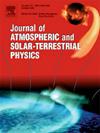The global circuit capacitor and two new ways of deriving the time constant of the global atmospheric electric circuit
IF 1.9
4区 地球科学
Q3 GEOCHEMISTRY & GEOPHYSICS
Journal of Atmospheric and Solar-Terrestrial Physics
Pub Date : 2025-05-19
DOI:10.1016/j.jastp.2025.106545
引用次数: 0
Abstract
Temporal smoothing of the electrical impulses generated by lightning and shower clouds occurs through the global atmospheric electric circuit (GEC); smoothing is quantified by the time constant of the GEC. Two new methods for calculating this time constant are presented. They are based a) on a novel global circuit capacitor model, rather than the Earth-ionosphere capacitor model, and b) on the concept of dielectric relaxation time of near-surface poorly conducting air. The new GEC model considers the contributions of stratus clouds and their changes to the electrical conductivity of the air. Using model a), the time constants for the various regions of the atmosphere, over land and oceans, are obtained and the GEC time constant is found to be ∼10 min. This compares very favourably with the time constant derived from recent observations of the effects of sudden volcanic lightning on the GEC. The upper “pseudo-electrode” of the capacitor, the actual value of whose constant potential varies according to the conditions present, is found to be at an altitude of 1.8 km. For model b), the upper pseudo-electrode is placed at the boundary between dielectric and conducting atmospheres, i.e. where the displacement current equals the conduction current. Its altitude is 2.0 km, in the vicinity of stratiform clouds; the GEC time constant is 7.6 min. The vertical profile of air conductivity which best fits both DC GEC and AC (Schumann resonance) considerations is presented. Smoothing from the GEC's time constant provides steady background conditions for stratiform cloud edge charging which may affect their properties in the climate system; the steady conditions are also exploited biologically, e.g., by spiders and their webs. Other connections between atmospheric electricity and various living species are briefly explored.
全球电路电容器及两种新的求全球大气电路时间常数的方法
闪电和阵雨云产生的电脉冲的时间平滑是通过全球大气电路(GEC)实现的;平滑是量化的时间常数的GEC。提出了计算该时间常数的两种新方法。它们是基于a)一个新的全球电路电容器模型,而不是地球电离层电容器模型,和b)近表面低导电性空气的介电弛豫时间的概念。新的GEC模型考虑了层云及其变化对空气电导率的贡献。使用模式a),获得了陆地和海洋上空大气各区域的时间常数,发现GEC时间常数为~ 10分钟。这与最近对突然火山闪电对GEC影响的观测所得的时间常数非常吻合。电容器的上部“伪电极”,其恒定电位的实际值根据目前的条件而变化,被发现位于1.8公里的高度。对于模型b),上部伪电极放置在介电气氛和导电气氛的边界处,即位移电流等于传导电流的地方。其高度为2.0 km,在层状云附近;给出了最适合直流GEC和交流(舒曼共振)考虑的空气电导率的垂直剖面。GEC时间常数的平滑为层状云边缘电荷提供了稳定的背景条件,这可能会影响它们在气候系统中的性质;稳定的环境也被生物利用,例如蜘蛛和它们的网。简要探讨了大气电与各种生物之间的其他联系。
本文章由计算机程序翻译,如有差异,请以英文原文为准。
求助全文
约1分钟内获得全文
求助全文
来源期刊

Journal of Atmospheric and Solar-Terrestrial Physics
地学-地球化学与地球物理
CiteScore
4.10
自引率
5.30%
发文量
95
审稿时长
6 months
期刊介绍:
The Journal of Atmospheric and Solar-Terrestrial Physics (JASTP) is an international journal concerned with the inter-disciplinary science of the Earth''s atmospheric and space environment, especially the highly varied and highly variable physical phenomena that occur in this natural laboratory and the processes that couple them.
The journal covers the physical processes operating in the troposphere, stratosphere, mesosphere, thermosphere, ionosphere, magnetosphere, the Sun, interplanetary medium, and heliosphere. Phenomena occurring in other "spheres", solar influences on climate, and supporting laboratory measurements are also considered. The journal deals especially with the coupling between the different regions.
Solar flares, coronal mass ejections, and other energetic events on the Sun create interesting and important perturbations in the near-Earth space environment. The physics of such "space weather" is central to the Journal of Atmospheric and Solar-Terrestrial Physics and the journal welcomes papers that lead in the direction of a predictive understanding of the coupled system. Regarding the upper atmosphere, the subjects of aeronomy, geomagnetism and geoelectricity, auroral phenomena, radio wave propagation, and plasma instabilities, are examples within the broad field of solar-terrestrial physics which emphasise the energy exchange between the solar wind, the magnetospheric and ionospheric plasmas, and the neutral gas. In the lower atmosphere, topics covered range from mesoscale to global scale dynamics, to atmospheric electricity, lightning and its effects, and to anthropogenic changes.
 求助内容:
求助内容: 应助结果提醒方式:
应助结果提醒方式:


